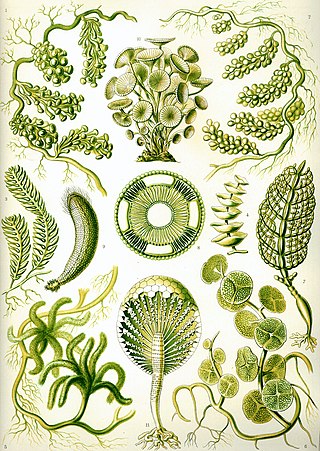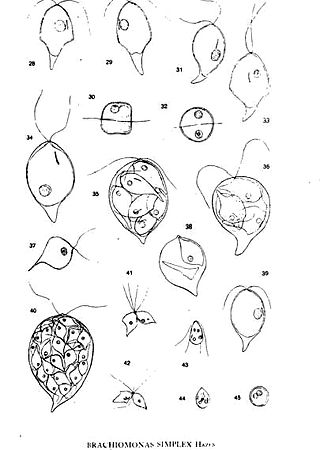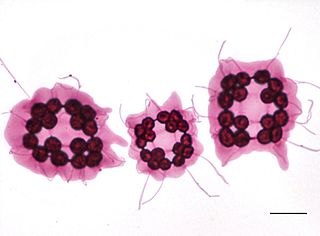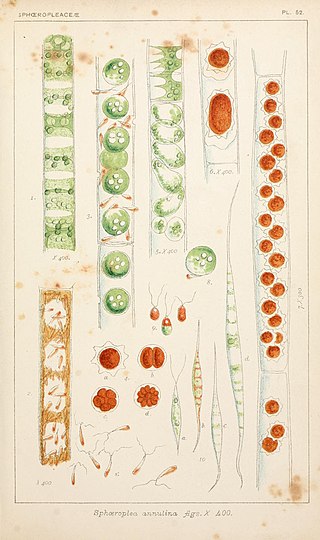
The Chlorophyceae are one of the classes of green algae, distinguished mainly on the basis of ultrastructural morphology. They are usually green due to the dominance of pigments chlorophyll a and chlorophyll b. The chloroplast may be discoid, plate-like, reticulate, cup-shaped, spiral- or ribbon-shaped in different species. Most of the members have one or more storage bodies called pyrenoids located in the chloroplast. Pyrenoids contain protein besides starch. Some green algae may store food in the form of oil droplets. They usually have a cell wall made up of an inner layer of cellulose and outer layer of pectose.

Chlorophyta is a division of green algae informally called chlorophytes.

Volvox is a polyphyletic genus of chlorophyte green algae in the family Volvocaceae. Volvox species form spherical colonies of up to 50,000 cells, and for this reason they are sometimes called globe algae. They live in a variety of freshwater habitats, and were first reported by Antonie van Leeuwenhoek in 1700. Volvox diverged from unicellular ancestors approximately 200 million years ago.

Hydrodictyaceae is a family of green algae in the order Sphaeropleales. They are found in freshwater habitats worldwide.
In botany, a zoid or zoïd is a reproductive cell that possesses one or more flagella, and is capable of independent movement. Zoid can refer to either an asexually reproductive spore or a sexually reproductive gamete. In sexually reproductive gametes, zoids can be either male or female depending on the species. For example, some brown alga (Phaeophyceae) reproduce by producing multi-flagellated male and female gametes that recombine to form the diploid sporangia. Zoids are primarily found in some protists, diatoms, green alga, brown alga, non-vascular plants, and a few vascular plants. The most common classification group that produces zoids is the heterokonts or stramenopiles. These include green alga, brown alga, oomycetes, and some protists. The term is generally not used to describe motile, flagellated sperm found in animals. Zoid is also commonly confused for zooid which is a single organism that is part of a colonial animal.
Atractomorpha is a genus in the Sphaeropleaceae, a family of green algae. The genus name is derived from Greek and means "spindle-shaped" or "arrow-shaped", and refers to the shape of the cells.

Brachiomonas is a genus of thalloid biflagellate green algae. These algae generally are found in marine or brackish waters, but can tolerate wide range of salinities. They may occur in freshwater pools near the sea and, occasionally, in polluted inland freshwater habitats.
Characiosiphon is a genus of green algae in the family Characiosiphonaceae. It contains a single species, Characiosiphon rivularis.
Lobocharacium is a genus of green algae in the family Characiosiphonaceae. It contains the single species Lobocharacium coloradoense. It has been isolated from a pond in Colorado, United States.

Pediastrum is a genus of green algae, in the family Hydrodictyaceae. It is a photoautotrophic, nonmotile coenobial green alga that inhabits freshwater environments. The name Pediastrum comes from the Greek root words pedion, meaning "plane", and astron, meaning "star", referring to its overall shape.

Platydorina is a genus of microscopic green algae in the family Volvocaceae. It contains only one species, Platydorina caudata. It was described by Charles Atwood Kofoid in 1899.

Sorastrum is a genus of green algae in the family Hydrodictyaceae. It is a component of the phytoplankton of freshwater ponds, lakes, and ditches. Sorastrum is common in tropical to temperate regions of the world, but due to its small size it is often overlooked.

Sphaeroplea is a genus of green algae in the family Sphaeropleaceae. It was first circumscribed by the Swedish botanist Carl Adolph Agardh in 1824.

Stephanosphaera is a genus of green algae in the family Haematococcaceae, containing the single species Stephanosphaera pluvialis. It forms colonies of flagellated cells. Although it was once placed in the family Volvocaceae, it is not closely related to them; its sister is the unicellular genus Balticola. The name comes from the Greek roots stephanos, meaning "crown", and sphaira, meaning "ball".

Trebouxia is a unicellular green alga. It is a photosynthetic organism that can exist in almost all habitats found in polar, tropical, and temperate regions. It can either exist in a symbiotic relationship with fungi in the form of lichen or it can survive independently as a free-living organism alone or in colonies. Trebouxia is the most common photobiont in extant lichens. It is a primary producer of marine, freshwater and terrestrial ecosystems. It uses carotenoids and chlorophyll a and b to harvest energy from the sun and provide nutrients to various animals and insects.
Vitreochlamys is a genus of green algae in the family Chlamydomonadaceae. It is sometimes known by the name Sphaerellopsis, published by Aleksandr Arkadievich Korshikov. However, that name is an illegitimate later homonym, preceded by SphaerellopsisM.C.Cooke. It is commonly found in freshwater habitats.
Deuterocharacium is a genus of green algae in the family Characiaceae. It is found in freshwater habitats, attached to algae or detritus. It is rare and has only been recorded from Europe.

Chlorotetraedron is a genus of green algae, in the family Neochloridaceae. The name may also be written as Chlorotetraëdon. It is found as freshwater plankton or in soil.
Bracteamorpha is a genus of green algae in the order Sphaeropleales, and is the only genus in the family Bracteamorphaceae. It contains a single species, Bracteamorpha trainorii.

Apiocystis is a genus of algae belonging to the family Tetrasporaceae. It is found attached to freshwater aquatic algae or plants. The species of this genus are found in Europe and Northern America, and are widespread but generally uncommon.












